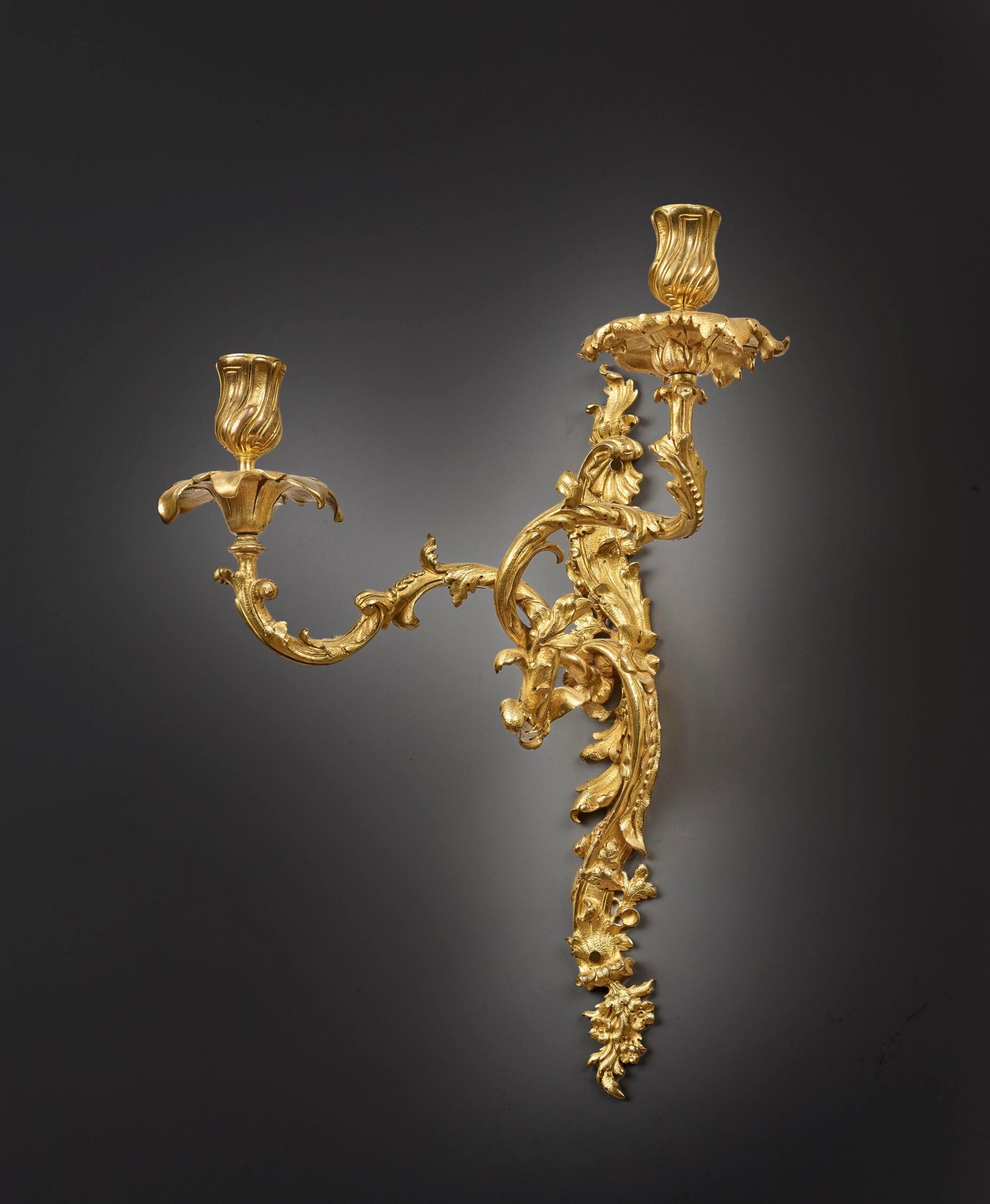Paris, Régence period, second quarter of the 18th century
Chased and gilt bronze
Close examples:
- Pair of wall lights with two arms, circa 1735, Los Angeles, J. Paul Getty Museum (inv. 78.DF.89)
- Pair of wall lights with two arms, New York, Metropolitan Museum (inv. 218 A,B)
- Pierre Mariette, Nouveaux Dessins de Meubles et Ouvrages de Bronze et de Marqueterie
Inventés et Gravés par André-Charles Boulle, between 1707 and 1730, Los Angeles, Getty Research institute (inv. NK.2550. B76 N93 1800Z)
- Attributed to André-Charles Boulle, Pair of wall lights, circa 1715, Los Angeles, J.-P. Getty Museum (inv. 97.DF.16.1–2)
It presents each with a central shaft in a tumultuous shape, with scrolls, adorned with a volute décor, flowers, acanthus leaves and oak. The shafts end on the bottom with a foliaged and flourished fall. Almost in the middle, in the centre of a flower, spring s up an arm, doubling with two rocaille branches interlacing, repeating the ornaments of the shaft.
The basins are shaped of blossomed and curved leaves. The bobeche are adorned of a rib pattern and various and stylised flutes.
Régence wall lights
This pair of two-branched wall light is characteristic of the models developed during the Régence, a period that extended from Louis XIV’s death in 1715 to Louis XV’s majority in 1723, during which Philippe d’Orléans exercised power. In artistic language, however, it cannot be summed up in the few years that Philippe d’Orléans was in power. Extending from the very beginning of the century to about 1730, it corresponds to a moment of intense creativity.
The artistic revolution initiated at the very end of the 17th century continued. It was marked by the blossoming of a youthful and light-hearted spirit. As early as 1699, Louis XIV wrote, in the margin of a project by Mansart for the Duchesse de Bourgogne’s apartments at the Château de La Menagerie, that “there is something to change, that the subjects are too serious and that there must be youth mixed in everything that is done”. The lightness and the gaiety of Jean Bérain’s grotesques (1640−1711) first, created after 1680, and of Claude III Audran (1658−1734) then, open the way to a laughing ornamentation and to curved forms in the decoration of which the gilt bronzes are a major testimony.
The mantelpiece was the main focus of a room at that time, some of the most remarkable git bronze accessories were grouped around it, such as firedogs, torches or girandoles, placed on the mantle, or light arms fixed directly on the frame of the glass overmantel.
These numerous works of art attracted the attention of the designers of the time, who imagined a great variety of forms. The arms of light were thus the subject of a profusion of drawings of which those of André-Charles Boulle (1642−1732) marked an important milestone. Known by their engraving by Jean Mariette (1660−1742), after 1707 and before 1730, they contributed to the emergence of a lighter aesthetic where asymmetrical ornaments became more and more present.
They also correspond to the birth of a new mode of lighting, the plate being then outranked by the arm, on which the branches played a decorative role as important as the element fixed onto the wall. Hanging on both side of the mirrors, their multiplied lights illuminated the room with an extra sparkle.
Dating from the 1720s, these wall lights are representative of the evolution of their forms during the early Régence period. They take up the principle developed at the beginning of the century associated to a rather discreet shaft arms taking more and more importance. The base is still marked by the aesthetics of the beginning of the century, circumscribed in a straight form, the desire of asymmetry being however transpiring in the volute constituting the main frame at the beginnings of the Rocaille art.
It is thus essentially the branches that reveal the evolution that begun under the Régence towards more exuberant lines, each being treated differently, like the stems of an imaginary plant.
Bibliography
- Calin Demetrescu, Le style Régence, Paris, Éditions de l’Amateur, 2003.
- Sous la direction de João Castel-Branco Pereira, Designing the Décor – French drawings from the 18th century, Lisbon, Calouste Gulbenkian Foundation, 2005.
- Hans Ottomeyer, Peter Pröschel, Vergoldete bronzen, Die Bronzearbeiten des Spätbarock und Klassizismus, München, Klinkhardt & Biermann, 1986, vol. 1, pp. 64, 66–67.
- Gilles-Marie Oppenord (1672−1742), Recueil des œuvres de Gilles-Marie Oppenord, Premier architecte de Monseigneur le duc d’Orléans, Régent du Royaume, planche CVII, imprimé par Gabriel Huquier (1695−1772), après 1742, Cooper-Hewitt, National Design Museum, Smithsonian, New York, Gift of the Council, inv. 1921−6−216−74
- Pierre Verlet, Les bronzes dorés français du xviiie siècle, Paris, Picard, 1987.
Measurements:
- Height: 41 cm – 16 inches
- Width: 31 cm – 12 inches
